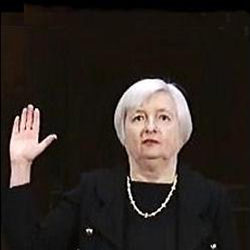By Pam Martens and Russ Martens: December 15, 2017

Janet Yellen, Chair of the Federal Reserve, Taking the Oath at Her Senate Confirmation Hearing in 2013
During Janet Yellen’s last press conference as Federal Reserve Chair on Wednesday, Donna Borak, the Senior Economics Writer at CNN, asked Yellen a question regarding the proposed tax cut. Borak queried:
“To return back to the prospective tax bill questions, in your view at all is the Republican tax bill an ill-timed fiscal stimulus, and are you concerned at all it will wind up squandering the tools both the Congress and the Fed have when it comes time to dealing with the recession?”
Yellen answered as follows:
“So look, I will just say that it is up to the administration and Congress to decide on appropriate fiscal policy, and our job is to maintain our focus on employment and inflation. We continue to think, as you can see from the projections, that a gradual path of rate increases remains appropriate even with almost all participants now factoring in their assessment of the impact of the tax policy. You know, it is projected that the tax cut package will lead to additions to the national debt and boost, by the end of the horizon, the debt to GDP ratio. And I will say, and this is nothing new, this is something I’ve been saying for a long time, I am personally concerned about the U.S. debt situation.
“It’s not that the debt to GDP ratio at the moment is extraordinarily or worrisomely high, but it’s also not very low. And it’s projected, as the population continues to age and the baby boomers retire, that that ratio will continue to rise in an unsustainable fashion. So the addition to the debt, taking what is already a significant problem and making it worse is, it is of concern to me, and I think it does suggest that in some future downturn, which well could occur just for whatever reason, the amount of fiscal space that would exist for a fiscal policy to play an active role, it will be limited, may well be limited.”
Yellen’s take on the national debt and the projected $1 trillion that will be added to it as a result of Trump’s proposed tax cut fails to capture the unprecedented and dangerous growth of the national debt under both Wall Street Democrat and Republican administrations.
When Bill Clinton took office in January 1993, the U.S. national debt stood at $4 trillion. The country was then more than two centuries old. The U.S. had paid for the Revolutionary War, the Civil War. It had financed Franklin Delano Roosevelt’s New Deal programs to provide jobs and stimulus during the Great Depression. The nation had also paid for World Wars I and II and the Vietnam War. When President Obama took office in January 2009, the national debt stood at $10.6 trillion as the government and Fed began pumping out money to compensate for the Wall Street collapse and ensuing economic crisis.
Today, the national debt stands at $20.6 trillion. It has almost doubled since President Obama took office and now a Republican President wants to add a trillion dollars to this unprecedented acceleration of debt.
Neither Trump nor Yellen appear to understand why GDP is lagging in the United States. The late MIT economist, Lester Thurow, explained today’s problem almost 30 years ago. In a foreward Thurow wrote in Ravi Batra’s book, “The Great Depression of 1990,” Thurow outlined the economic dilemma of a society in which vast wealth is concentrated in too few hands. Thurow wrote:
“Depression is seen as a product of systematic tendencies for the distribution of wealth to become concentrated among a few. When this happens, demand eventually sags relative to supply and long cyclical downturns commence. Unlike some cyclical analysts, Batra believes that such cycles are not inevitable and can be controlled with social policies essentially designed to stop undue concentration of wealth from developing.
“Essentially, the economic problem is like that of the wolf and the caribou. If the wolves eat all the caribou, the wolves also vanish. Conversely, if the wolves vanish, the caribou for a time multiply but eventually their numbers become too great and they die for lack of food. Producers need consumers, and if producers deprive workers of their fair share of production income they essentially deprive themselves of the affluent consumers they need to make their facilities profitable. One could think of Batra’s argument as a kind of economic ecology where there is a ‘right’ environmental balance.”
The depression that Batra wrongly had in mind for 1990 became the Great Recession that followed the 2008 Wall Street crash. Its underpinnings clearly were a Wall Street business model of fraud and an institutionalized wealth transfer system from the 99 percent to the 1 percent, leaving the U.S. with the greatest wealth inequality since the late 1920s.
The answer to this problem is decidedly not a tax cut for the richest Americans and a ballooning national debt.

